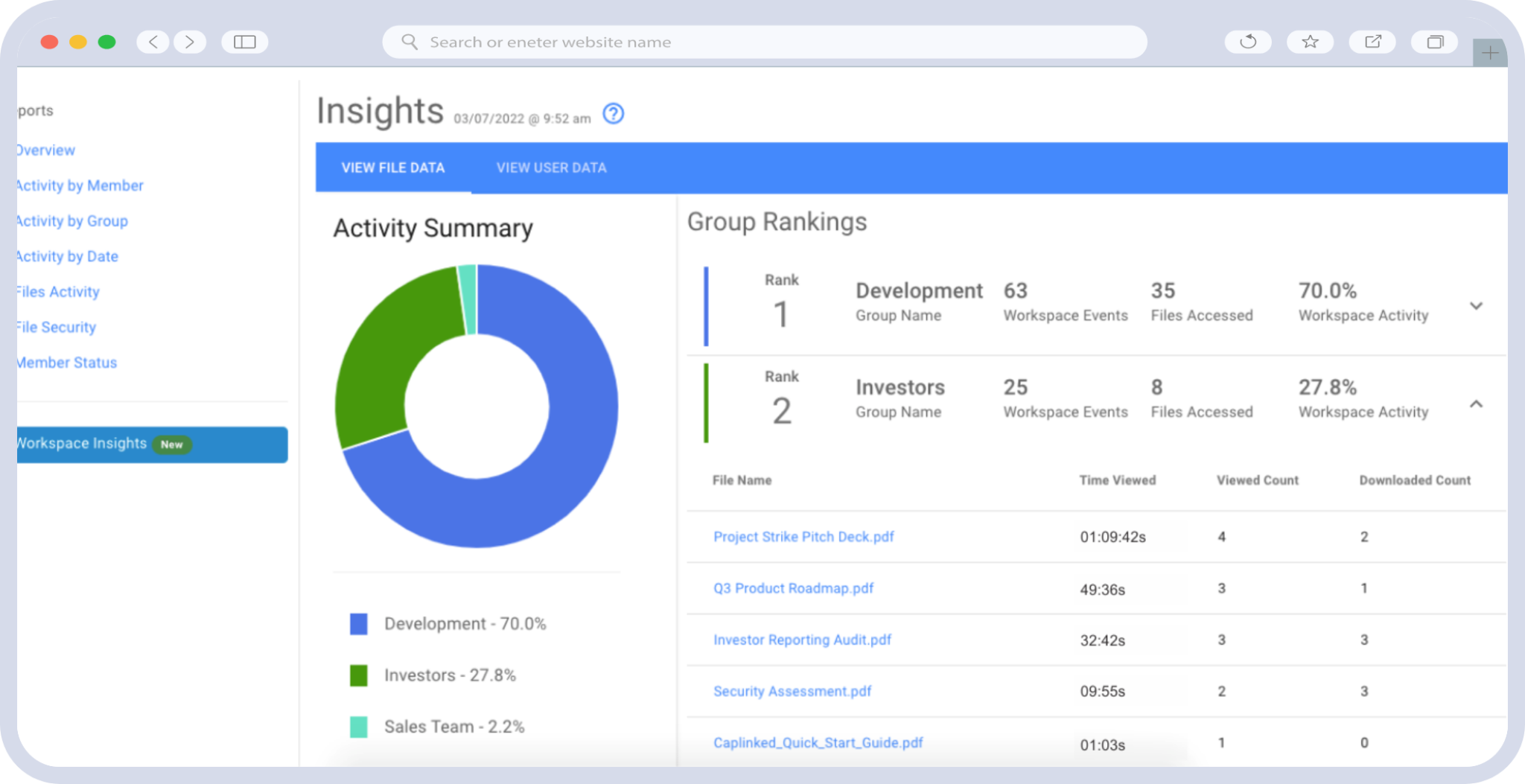Virtual data rooms (VDRs) are no longer just deal repositories. In 2025, they’re the operational core for sensitive collaboration—where due diligence, audits, and regulated information sharing actually happen. That shift is most visible in the public sector and regulated industries that work with the U.S. government, defense programs, and critical infrastructure. In these environments, AWS GovCloud (US) has become the reference standard: a physically and logically isolated cloud built to run unclassified but highly regulated workloads under the tightest U.S. controls.
For teams evaluating where to run a high-assurance VDR—agency buyers, primes and subs, defense tech, critical infrastructure operators, or enterprises handling controlled data for government clients—the question isn’t “can the VDR encrypt files?” It’s “will the platform, its admins, and its infrastructure withstand regulatory scrutiny on day one—and on the worst day?” AWS GovCloud is engineered to make that answer a confident yes.
This article unpacks what makes GovCloud different, how those differences map directly to VDR needs, and what a future-proof deployment looks like when FedRAMP High, DoD SRG IL4/IL5, ITAR, CJIS, HIPAA, and IRS 1075 are not acronyms in a deck but real operating constraints.
Table of Contents
ToggleWhat AWS GovCloud Actually Is (and Isn’t)
GovCloud is not just “AWS with a badge.” It is a separate pair of U.S. regions (East and West) built for U.S. government workloads and U.S.-regulated data. Several properties matter for VDRs:
- Isolation and sovereignty. GovCloud regions are physically and logically isolated from commercial AWS. Operations are performed by screened U.S. citizens on U.S. soil. That “U.S. persons only” boundary is foundational for ITAR and certain CJIS requirements.
- Control inheritance. GovCloud maintains a FedRAMP High authorization and implements additional controls aligned to DoD SRG IL4/IL5. VDR providers and agencies inherit a large portion of those controls when they build in GovCloud—reducing certification effort and audit friction.
- Service parity with guardrails. The region exposes the core AWS services—compute, storage, networking, identity, key management, HSM, logging/monitoring—with FIPS-validated cryptography endpoints and a curated service set appropriate to high baseline workloads.
For VDR buyers, this translates to a platform that bakes in data residency, personnel restrictions, cryptographic assurance, and logging rigor—before your first user uploads a single file.
Why VDRs Belong on GovCloud When Stakes Are High
Most VDR features look similar in a marketing matrix—permissions, watermarks, redaction, Q&A. In practice, assurance is what differentiates a commodity “file portal” from a system agencies and primes will trust. GovCloud addresses assurance on multiple layers that matter to a VDR:
1) Sovereign operations you can defend
A significant slice of sensitive collaboration involves Controlled Unclassified Information (CUI), Federal Contract Information (FCI), export-controlled technical data (ITAR), or Criminal Justice Information (CJI). Each has personnel and location constraints. GovCloud’s U.S.-only administration, U.S. data residency, and isolated endpoints remove entire classes of risk discussions: who can touch the infrastructure, where are the logs, can traffic egress to non-U.S. regions by mistake? You start from the compliant default.
2) FedRAMP High & DoD SRG alignment
A VDR built on GovCloud can inherit controls across physical security, boundary protection, media sanitation, configuration management, and logging. For program offices and AO (Authorizing Official) teams, that inheritance is the difference between months of debate and weeks of review. When the underlying platform already meets the high bar, you can focus your ATO work on the application layer (roles, workflows, data lifecycle) instead of re-proving data center basics.
3) FIPS-validated crypto everywhere
VDRs live and die by their encryption story. On GovCloud, TLS endpoints and KMS/HSM backends operate with FIPS 140-2 validated modules; storage (S3/EBS/RDS/DynamoDB) supports at-rest encryption with customer-managed keys, and CloudHSM offers FIPS 140-2 Level 3 hardware when you need dedicated modules. As a result, you can enforce encryption end-to-end with key custody models that satisfy risk officers and government customers.
4) Real-time, immutable telemetry
A defensible VDR is an observable VDR. GovCloud’s audit fabric—CloudTrail, CloudWatch, VPC Flow Logs, Config, plus Security Hub and GuardDuty—provides the telemetry to answer who/what/when/where/why questions without guesswork. In an incident, you need tamper-evident logs that tie an action to a principal and a route; GovCloud delivers that with integrity validation and private log buckets.
5) Compartmentalization without complexity
Most regulated projects require fine-grained isolation—per program, per deal, per agency. On GovCloud, you can design a VDR to map each “room” to its own S3 buckets, KMS keys, and database tenants, then enforce least privilege with IAM roles and resource tags. That’s compartmentalization by architecture, not policy alone.
A Reference Architecture for a GovCloud VDR
While each agency and prime will tune specifics, a high-assurance pattern tends to look like this:
- Identity & Access: AWS IAM with SSO (e.g., IdP via SAML/OIDC). Enforce MFA, conditional access (IP/Geo/Device posture), and session policies. Use permission boundaries and scoped roles for external reviewers.
- Storage & Keys: S3 for documents with bucket policies that require encryption and TLS, object-level logging, Object Lock (write-once) for legal holds. Keys in AWS KMS with per-room CMKs; CloudHSM for programs that demand dedicated HSMs or external key control. Enable automatic key rotation; restrict decrypt to room-scoped roles.
- Compute: Stateless application tiers on EC2 or container services in private subnets; ALB/NLB fronted by WAF. VPC endpoints (PrivateLink) to S3/KMS so data never traverses the public internet.
- Networking: Multi-AZ subnets, tightly scoped security groups, centralized egress through NAT + VPC endpoints; optionally Direct Connect from on-prem SOCs. Route 53 private zones for internal service discovery.
- Observability & IR: CloudTrail org-level aggregation, log integrity validation, CloudWatch metrics/alarms, GuardDuty detections piped to a SIEM/SOAR. Incident runbooks codified in automation (e.g., isolate user/role, quarantine bucket prefix, rotate CMKs).
- Data Lifecycle: Lifecycle policies per bucket (retention windows matched to contract), automatic server-side redaction pipelines where required, checksum verification on upload, content hashing for chain-of-custody.
This blueprint gives security leaders what they need (provable controls) and program managers what they want (speed to ATO and smooth onboarding for external reviewers).
Mapping GovCloud Controls to Common VDR Requirements
Below is a pragmatic lens: the operational questions you’ll actually be asked—and how GovCloud helps answer them.
“Can you restrict access to U.S. persons and keep data in the U.S.?”
Yes. GovCloud regions are U.S.-only with U.S.-citizen administration. Data residency is U.S. by design. Access to workloads is governed by IAM, network boundaries, and your IdP.
“Do you use FIPS-validated crypto?”
Yes. GovCloud TLS endpoints are FIPS; KMS and CloudHSM provide FIPS-validated key services; storage encryption is enforced with KMS CMKs.
“Show me who accessed a document, from where, and when.”
CloudTrail + application logs + VPC Flow Logs provide that attribution. Write logs to dedicated, write-only S3 buckets with Object Lock and Enable Log File Validation for tamper evidence.
“How do you segregate one agency’s room from another?”
Per-room S3 buckets, per-room CMKs, per-room IAM roles, and database tenancy. Tag resources; write SCPs and permission boundaries to enforce scoping.
“Can we bring our own keys or HSMs?”
Yes. Use customer-managed KMS keys; for stricter regimes, integrate CloudHSM or external KMS via validated patterns.
“What happens during an incident?”
Automated isolation (disable suspect roles, block policy on affected prefixes, rotate keys), immutable log capture, and forensics with snapshotting and object versioning. Security Hub/GuardDuty findings feed runbooks, and notifications go to the incident channel.
FedRAMP High, DoD SRG IL4/IL5, ITAR, CJIS—What Matters in Practice
FedRAMP High is the high-water mark for unclassified cloud security. Building your VDR on GovCloud lets you inherit High baseline controls, which accelerates agency ATOs and reduces documentation payload.
DoD SRG IL4/IL5 applies to defense workloads containing CUI and mission-sensitive data. GovCloud alignment to IL5 with additional DoD requirements means defense programs can deploy a VDR without carving exceptions around personnel or region controls.
ITAR obligates you to keep technical data under U.S. person control. GovCloud’s U.S.-only operations plus your U.S.-only IAM and HR controls form the defense-in-depth you need.
CJIS requires state law-enforcement entities to protect CJI with personnel vetting and technical safeguards. GovCloud supports state CJIS programs through contractual and technical measures (e.g., fingerprinted admin personnel, FIPS crypto, detailed logging).
The takeaway: GovCloud gives your security team pre-answered questions for these regimes, letting the VDR’s application layer focus on permissions, watermarking, redaction, Q&A, and collaboration experience.
Performance and Usability: High Assurance Without Slowing the Deal
A common fear is that “government-grade” means “slow and painful.” It doesn’t have to. A well-built GovCloud deployment can feel as fast as a commercial SaaS—and often faster under load—if you design for the path of least latency:
- Multi-AZ and regional choice. Pick GovCloud East or West based on user concentration. Distribute static assets via CloudFront if needed (with regional restrictions).
- Chunked, parallel uploads with checksums. Client SDKs can push multi-GB deals efficiently while preserving integrity and resumability.
- Search and preview at scale. Index metadata (title, SHA-256, tags, ACLs) in a managed search tier; generate secure previews server-side to avoid leaking content to clients.
- Least-privilege caching. Signed URLs with tight TTLs keep the UX snappy while preserving zero-trust principles.
Deal teams should not feel like they are “in a bunker” just because the platform is compliant. Modern GovCloud deployments deliver consumer-grade responsiveness with regulator-grade controls.
Designing for Auditors (and Future You)
The best time to think about audits is before anyone asks. On GovCloud, you can make audit readiness a default outcome:
- Log everything by design. Turn on org-level CloudTrail; centralize logs to a security account; enable integrity validation.
- Codify retention. Attach lifecycle policies to buckets by room and contract; prevent ad-hoc deletes; use Object Lock for legal holds.
- Evidence packs. Automate export of access logs, config snapshots, and key policies into time-boxed “evidence packs” you can hand to oversight bodies.
- Prove negative events. Structure logs so you can show that nobody outside the approved cohort accessed data during a window—critical for incident reporting.
Auditors don’t need glossy screenshots. They need provable signals. GovCloud’s telemetry gives you those signals; your VDR should make them one click away.
Practical Migration: From Commercial Cloud to GovCloud
Many organizations start on a commercial cloud VDR and later face a contract or program that mandates GovCloud. A smooth migration respects chain-of-custody and minimizes user disruption:
- Prepare the landing zone. Baseline accounts, guardrails (SCPs), IAM roles, logging, key hierarchy, and VPC endpoints.
- Establish parallel runs. Mirror new rooms in GovCloud while existing rooms wind down in commercial; dual-write logs to both for audit continuity.
- Deterministic transfer. Use checksum-verified copy (e.g., S3 to S3 via VPC endpoints); maintain original timestamps and metadata where permitted.
- Rebind identity. Cut over SSO and role mappings; test least-privilege; rotate secrets/keys post-migration.
- Validate and attest. Run reconciliation reports, compare object counts and hashes, and produce a migration attestation for counsel and the AO.
Do it once with rigor and you won’t have to explain anomalies a year later.
A Buyer’s Checklist for a GovCloud-Based VDR
Keep lists short and high-value. These questions separate marketing from reality:
- Region and personnel: Are all services hosted exclusively in AWS GovCloud (US) with U.S.-person administration?
- Keys and crypto: Can we use customer-managed KMS keys per data room, with optional CloudHSM? Are all endpoints FIPS?
- Isolation: Is each room isolated across S3 buckets, CMKs, database tenants, and IAM roles?
- Logging: Are CloudTrail logs enabled org-wide with integrity validation and write-once retention?
- Network path: Do uploads/downloads stay on private endpoints (no public internet paths) when desired?
- Incident response: Are there codified runbooks for key rotation, user isolation, and evidence capture?
- Export/exit: Can we export documents, metadata, and audit logs without vendor-imposed friction or fees?
- Compliance scope: What control families are inherited from GovCloud, and which are implemented at the app layer?
If a provider can’t answer these cleanly, the platform isn’t ready for mission-critical collaboration.
The Road Ahead: GovCloud as the Collaboration Backbone
As AI oversight strengthens and cyber reporting deadlines shorten, the market is consolidating on platforms that can prove compliance in real time. For VDRs, GovCloud is that backbone. It gives builders the secure primitives—identity, keys, logging, networks—to construct systems that satisfy auditors without punishing users.
For agencies and contractors, the payoff is practical: faster ATOs, fewer carve-outs, simpler renewals, and less time in audit rooms. For enterprises that touch government workflows, GovCloud VDRs future-proof large accounts and open doors to programs that were previously off-limits.
The end state is clear: sensitive collaboration belongs on sovereign, observable, cryptographically enforced infrastructure. That’s what AWS GovCloud is, and that’s where the most demanding VDRs are heading.




